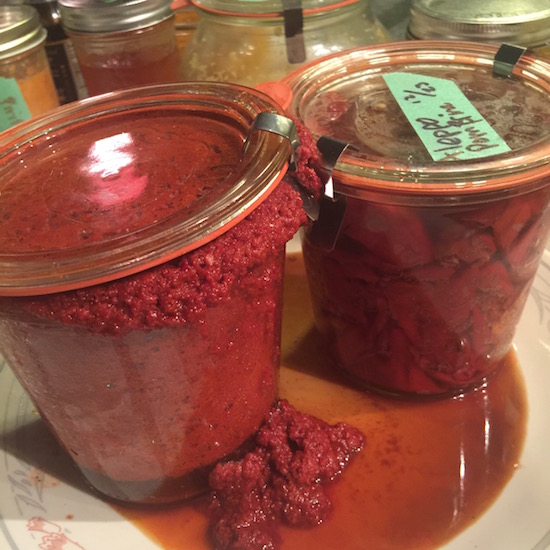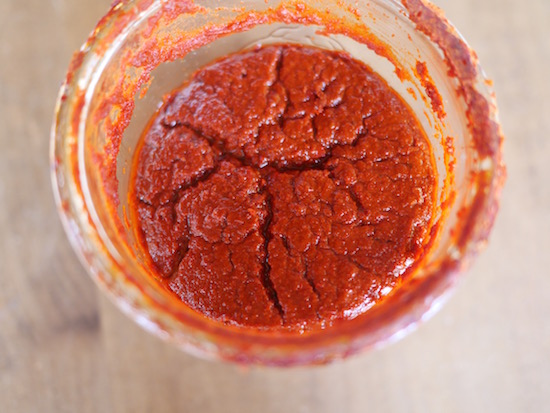Gochujang is a velvety, deep-red, rich Korean fermented hot pepper paste. It has a wonderful mix of sweet and hot, sour and salty. This paste is showing up in all manner of recipes (almost like it’s the new Sriracha or something.)
It is, however, a commitment to make in the traditional authentic sense (three months for one thing.) We have experimented quite a bit this last fall with the process and with recipes we have found in our research. We were surprised that it was hard to find definitive recipes. We did learn that all Korean households used to make their own but now very few do. We shared some pictures of the process on Instagram and soon our in-box had a number of requests for the recipe; unfortunately with the long fermentation time, we couldn’t really say what was great and what was not (and a few were not so good). Finally the “results” are in and we found the following two recipes to be quite delicious.
We based the first (traditional) recipe on the recipe by Emily Kim from her book Maangachi’s Real Korean Cooking: Authentic Dishes for the Home Cook, which incidentally has some wonderful ferments and recipes. We first used her blog recipe before the book was available and our adjustments came from her original blog recipe. Perhaps our biggest adjustment in all the traditional recipes that we tried was to significantly reduce the salt. The final flavor of this paste still has the important salty flavor element along with the rich sweet heat.
The second recipe is one we just came up with as we wanted to find away to make a gochujang-like flavor paste without the long-term extra credit fermenting project. We wanted something that would help folks make a natural no-additive fermented paste that doesn’t take as long or need a bunch of difficult to procure ingredients. This paste is quite complex and delicious despite being a “cheater’s gochujang”.
Note about Korean hot pepper powder: the commercially available powders ferment beautifully. The English translations on the labels can be off or confusing. Some are quite sweet and mild, while other powders in your kimchi will make your head sweat. If you are at an Asian market or on-line shopping for flakes, “maewoon gochugaru” means very hot, spicy, pepper flakes, and “deolmaewoon gochugaru” means milder. Try to find powders without added sugars or other additives, though most of the plain ones still contain a bit of salt. Here is a link to growing your own Korean kimchi peppers.
Traditional Gochujang
Yield: about ½ gallon
8 cups water
2 cups barley malt powder*
5 cups sweet rice flour, also called glutinous rice flour
1 cup fermented soy flour
6 cups Korean hot pepper powder see gochu, not flakes (gochujangyong gochugaru)
3 cups brown rice syrup
¾ cup salt
Mix the barley malt and warm water in a saucepan with a whisk, you want the water warm to the touch, about 100° F. Whisk in the rice flour. Allow to sit two hours.
Return pot to stove and cook at medium low heat until reduced by a third, about 1 to 2 hours. Stir regularly—this wants to stick to the bottom of the pot. Let this cool completely.
Stir in the fermented soy flour, hot pepper powder, rice syrup and salt. Mix until thoroughly mixed. It will be shiny and creamy.
Transfer to gallon jar, onggi pot, or your favorite fermenting vessel. Cover with cheesecloth and secure with a rubber band. Place the lid on jar or crock. Keep it at room temperature in a sunny window. On sunny days remove the lid and allow some sunlight to shine through the cheesecloth onto the ferment. In mid summer or in a hot climate move it to a cooler location in the afternoons. (Note: We have made it in the winter when the sunlight is minimal and have still had a delicious ferment.)
Ferment for 3 months. Transfer to the refrigerator to store.
* Barley malt powder: Malt is the key word here—it means that the barley has gone through a soaking and drying process that converts the starches into sugars. If you can find the kind that is labeled diastatic which has been soaked long enough to get the enzymes that break down the starches. Be careful though as some labeled as such contain dextrose and even wheat—not sure why. The takeaway is read your labels to get the pure product you are looking for. It can be found in Asian stores under the Korean name yeotgireum.
**Fermented soy flour found in Asian markets under the Korean name meju garu can be hard to source and can be replaced with Bob’s Red Mill organic soy flour. This works well as long as you use the malted barley.
“I-don’t-want-to-wait-3-months” Quick Gochujang
Yield: about 1 pint
2 cups water
3 tablespoons rice flour
3 tablespoons salt
1¼ – 1¾ cups Korean hot pepper powder see gochu (page 000), not flakes (gochujangyong gochugaru)
Add after 2 weeks of fermentation:
2 – 3 tablespoons brown rice syrup
Whisk the rice flour and salt int the water and then add the gochu powered. Mix until you have a smooth even consistency.
Follow the instructions for the type of fermentation vessel you are using. Press the paste into your fermentation vessel. If using the simple jar method select a mason jar that is sized appropriately to the amount of mash. Place the mash inside the jar leaving about 3 inches of airspace. Tighten lid. Set on your counter for 14 days.
This paste may float, leaving the brine below. This can be remedied one of two ways: open the lid slightly to “burp” the jar, reseal, and shake the jar to redistribute the contents. Or, open the jar, stir with a clean utensil and reseal. Test the ferment on day 14, though we like to let it go an extra week. It's ready when the flavors have mingled and there is an acidic vinegar-like quality to the flavor.
Stir in the brown rice syrup to taste. Allow to ferment for a few more days.
This ferment will keep, refrigerated for 12 months.




